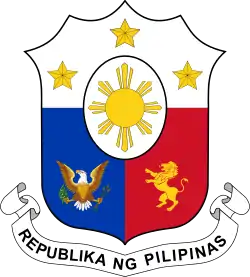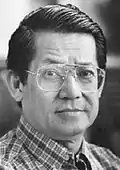1978 Philippine parliamentary election
A parliamentary election was held in the Philippines on April 7, 1978 for the election of the 165 regional representatives to the Interim Batasang Pambansa (the nation's first parliament). The elections were participated in by the leading opposition party, the Lakas ng Bayan (LABAN), which had twenty-one candidates for the Metro Manila area while the leading candidate was the jailed opposition leader Ninoy Aquino, and the Marcos regime's party known as the Kilusang Bagong Lipunan (KBL), which was led by the then-First Lady Imelda Marcos. Ninoy was allowed to run by his fellow partymates under the Liberal Party, who boycotted the election and was not allowed to campaign, and so his family campaigned for him. The night before the election on April 6, 1978, a noise barrage was organized by the supporters of (LABAN) which occurred up to dawn.
| ||||||||||||||||||||||||||||||||||||||||||||||||||||||||||||||||||||
179 (of the 189) seats in the Interim Batasang Pambansa 95 seats needed for a majority | ||||||||||||||||||||||||||||||||||||||||||||||||||||||||||||||||||||
|---|---|---|---|---|---|---|---|---|---|---|---|---|---|---|---|---|---|---|---|---|---|---|---|---|---|---|---|---|---|---|---|---|---|---|---|---|---|---|---|---|---|---|---|---|---|---|---|---|---|---|---|---|---|---|---|---|---|---|---|---|---|---|---|---|---|---|---|---|
| ||||||||||||||||||||||||||||||||||||||||||||||||||||||||||||||||||||
| ||||||||||||||||||||||||||||||||||||||||||||||||||||||||||||||||||||
 |
|---|
| This article is part of a series on the politics and government of the Philippines |
|
|
These elections were followed by the sectoral election on April 27, which elected additional 14 representatives. Another 10 representatives were appointed, bringing up the total number of representatives to 189.
Background
The Philippines had been under martial law since 1972, with incumbent president Ferdinand Marcos ruling by decree. Prior to this, the Constitution of the Philippines was being drafted by the Constitutional Convention, whose delegates were elected in 1970. The Constitutional Convention approved the final draft of the constitution, which consisted of the abolition of the Philippine Congress and its replacement with an interim National Assembly consisting of the President, the Vice-President, the President of the Constitutional Convention, and members of the Senate and the House of Representatives in November 1972 and was later ratified on January 17, 1973 through so-called "citizens' assemblies". The Constitution was amended twice, on July 27–28, 1973 and February 27–28, 1975. The Constitution was amended once again on October 16–17, 1976 with the passage of "Amendment No. 6", which changed the name of the Interim National Assembly into the "Interim Batasang Pambansa", more commonly as the "Batasan".
Campaign
Lakas ng Bayan
In 1978, from his prison cell, Aquino was allowed to take part in the elections. Although his friends, former Senators Gerry Roxas and Jovito Salonga, preferred to boycott the elections, Aquino urged his supporters to field 21 candidates in Metro Manila. Thus, his political party, dubbed Lakas ng Bayan ("People's Power"), was born. The party's acronym was "LABAN" ("fight" in Tagalog). He was entitled to one television interview on GTV's Face the Nation (hosted by Ronnie Nathanielsz), and proved to a startled and impressed populace that imprisonment had neither dulled his rapier-like tongue nor dampened his fighting spirit. Foreign correspondents and diplomats asked what would happen to the LABAN ticket. People agreed with him that his party would win overwhelmingly in an honest election. On April 6, 1978, supporters of the Lakas ng Bayan (LABAN), the opposition party headed by former Senator Benigno Aquino, Jr. who was still in jail and twenty other candidates contesting the Region IV-A (Metro Manila) seats, came out in protest by asking bystanders and cars to make noise in support the opposition.
Kilusang Bagong Lipunan
President Marcos created the Kilusang Bagong Lipunan (New Society Movement) as his political vehicle for the elections.
Results
The top bar represents seats won, while the bottom bar represents the proportion of votes received.
| District | Other | ||||||||||||||||
|
| ||||||||||||||||
|
|
District elections
| Party | Votes | % | Seats | |
|---|---|---|---|---|
| Kilusang Bagong Lipunan | 147,885,493 | 71.13 | 137 | |
| Lakas ng Bayan | 21,541,600 | 10.36 | 0 | |
| Pusyon Bisaya | 9,495,416 | 4.57 | 13 | |
| Bagong Lipunan-Kilusan ng Nagkakaisang Nacionalista, Liberal | 7,981,060 | 3.84 | 14 | |
| Mindanao Alliance | 6,685,224 | 3.22 | 1 | |
| Bicol Saro | 2,105,599 | 1.01 | 0 | |
| Young Philippines | 1,471,381 | 0.71 | 0 | |
| Concerned Citizens' Aggrupation | 1,374,549 | 0.66 | 0 | |
| Nacionalista Party | 688,130 | 0.33 | 0 | |
| Emancipated Scientists | 392,819 | 0.19 | 0 | |
| Partido ng Bagong Pilipino | 140,365 | 0.07 | 0 | |
| Democratic Party | 112,140 | 0.05 | 0 | |
| Philippine Labor Party | 94,287 | 0.05 | 0 | |
| Confederation of Ilocano Associations | 81,594 | 0.04 | 0 | |
| Consumers Party | 69,216 | 0.03 | 0 | |
| Citizens Union Progress Party | 44,893 | 0.02 | 0 | |
| Youth Democratic Movement | 40,571 | 0.02 | 0 | |
| Sovereign Citizens Party | 18,814 | 0.01 | 0 | |
| Partido Sambayanang Pilipino | 15,050 | 0.01 | 0 | |
| Lapiang Bagong Silang | 11,457 | 0.01 | 0 | |
| Bagong Anyo ng Buhay | 11,190 | 0.01 | 0 | |
| Independent | 7,633,851 | 3.67 | 1 | |
| Sectoral seats | 14 | |||
| Appointed seats | 10 | |||
| Total | 207,894,699 | 100.00 | 190 | |
| Registered voters/turnout | 21,464,213 | 85.52 | ||
| Source: Dieter Nohlen; Florian Grotz; Christof Hartmann; Graham Hassall; Soliman M. Santos. Elections in Asia and the Pacific: A Data Handbook: Volume II: South East Asia, East Asia, and the South Pacific. & Julio Teehankee. "Electoral Politics in the Philippines" (PDF). quezon.ph. | ||||
Sectoral election
See also
References
Further reading
- Philippine Commission on Elections — Records and Statistics Division
- Philippine House of Representatives Congressional Library
- Pobre, Cesar P. (2000). Philippine Legislature 100 Years. ISBN 971-92245-0-9.
.JPEG.webp)
